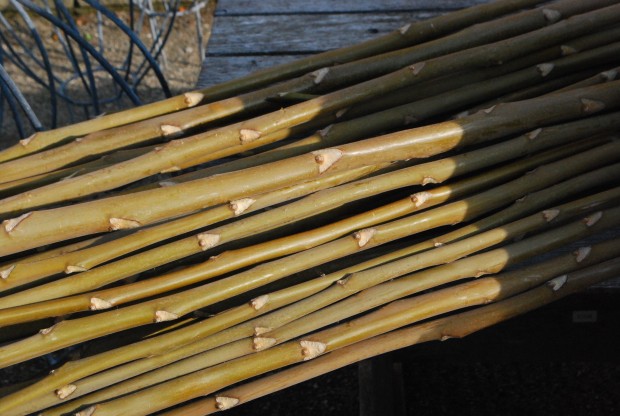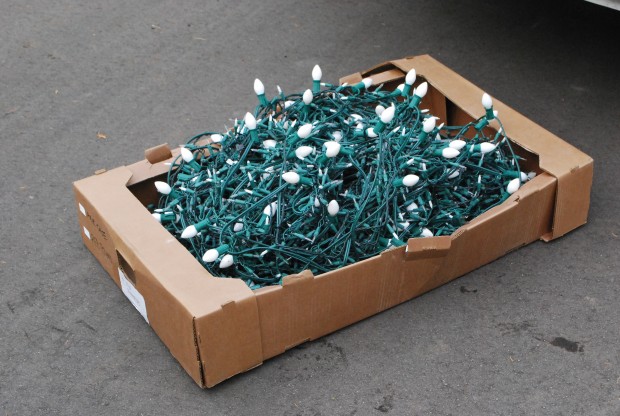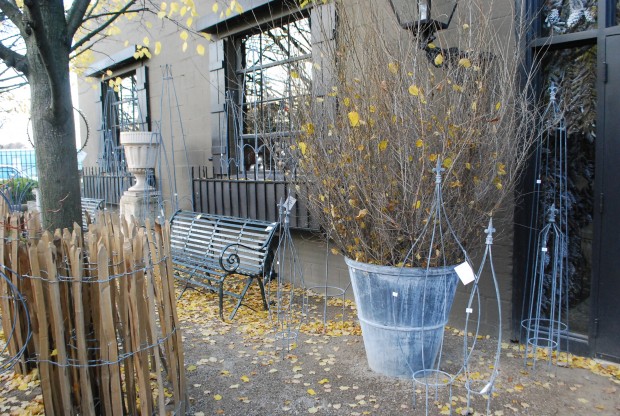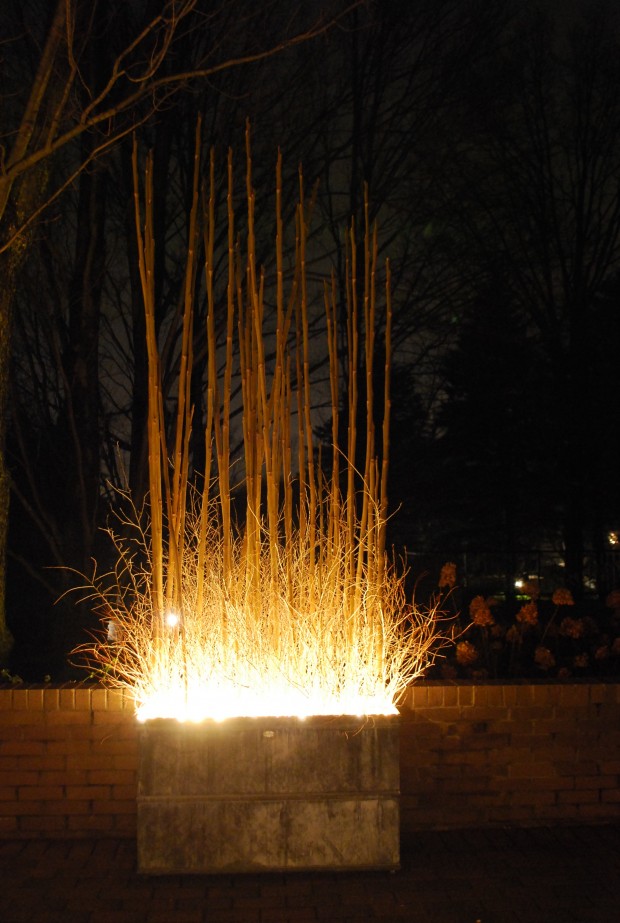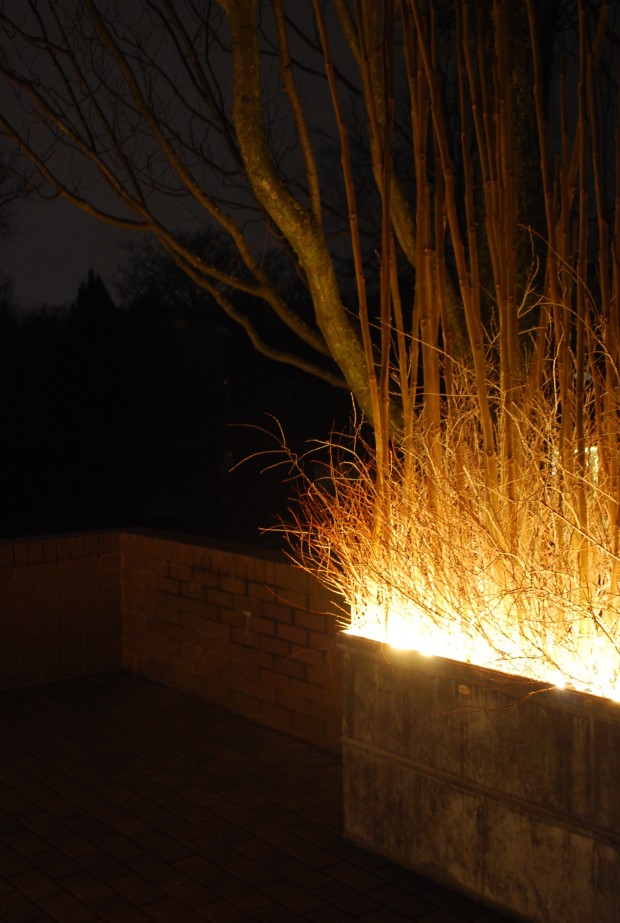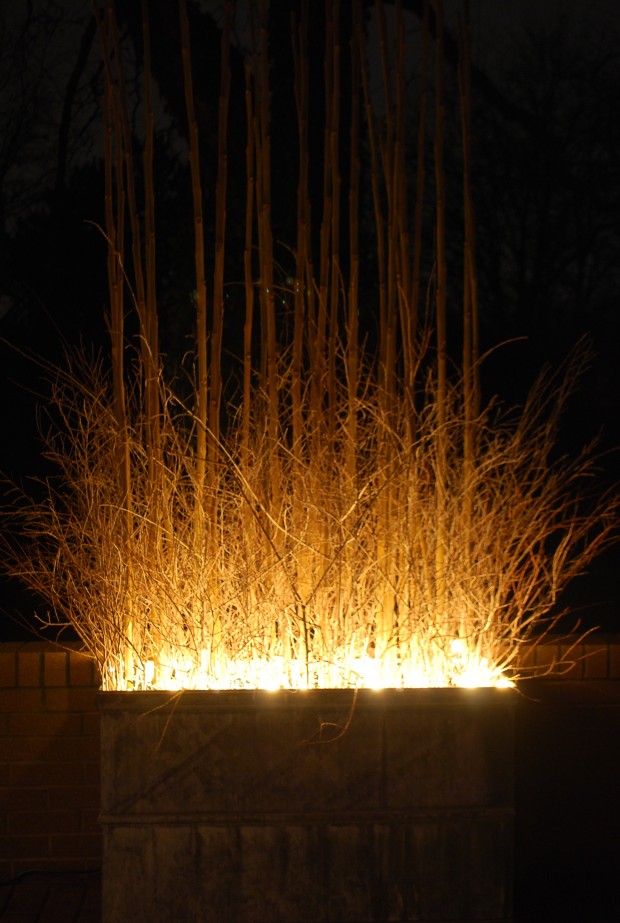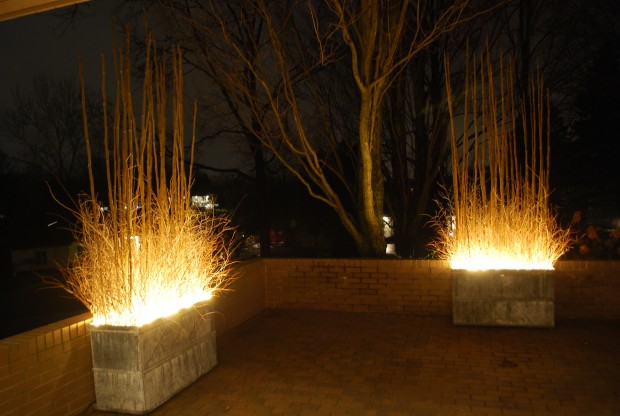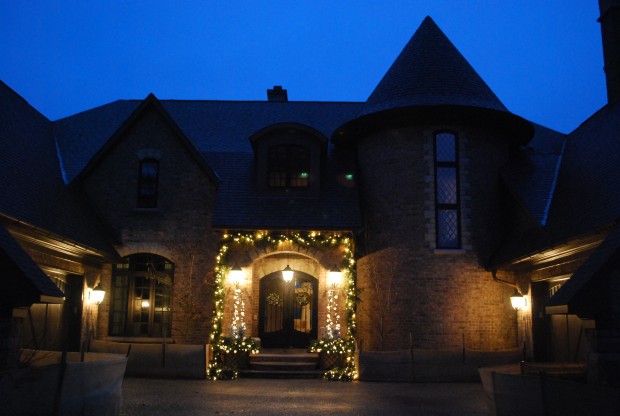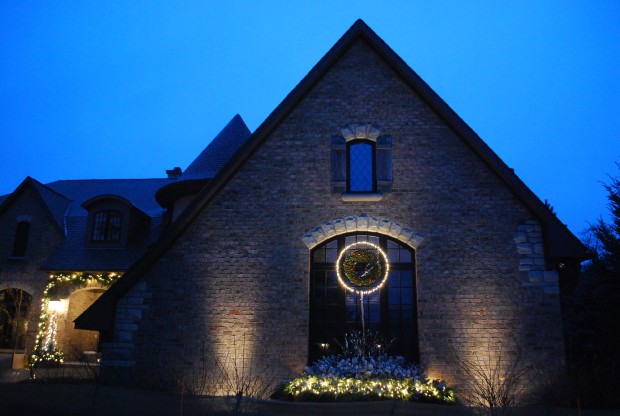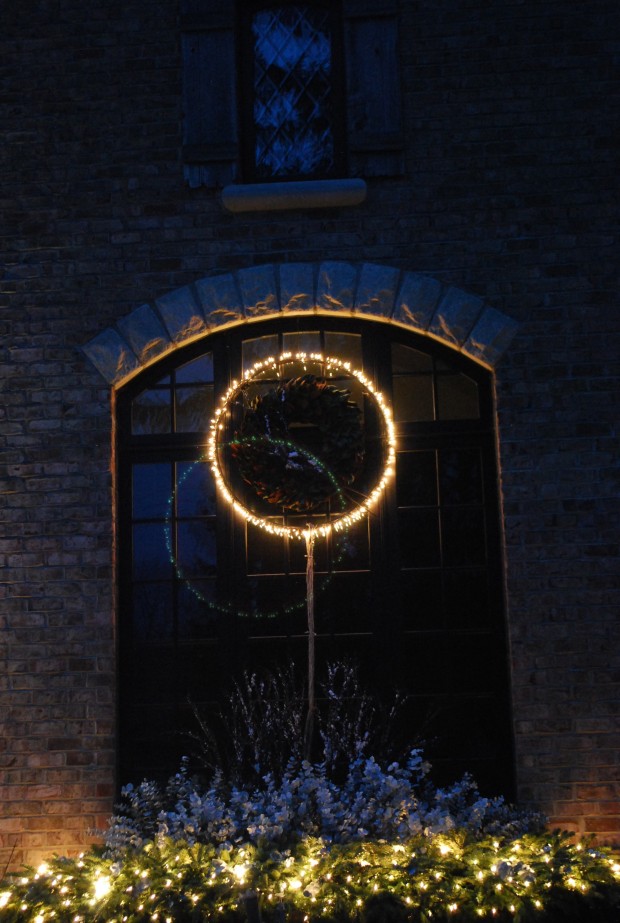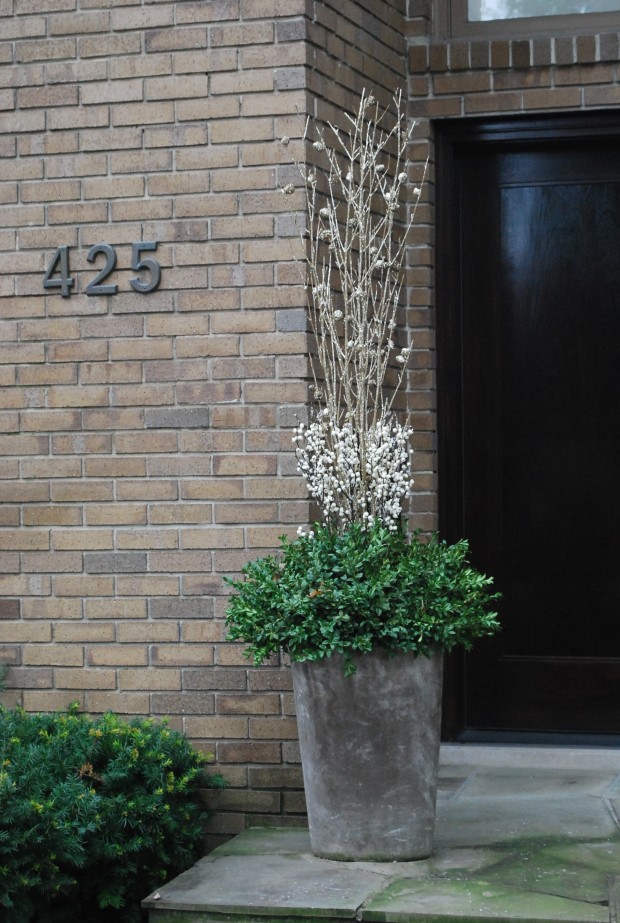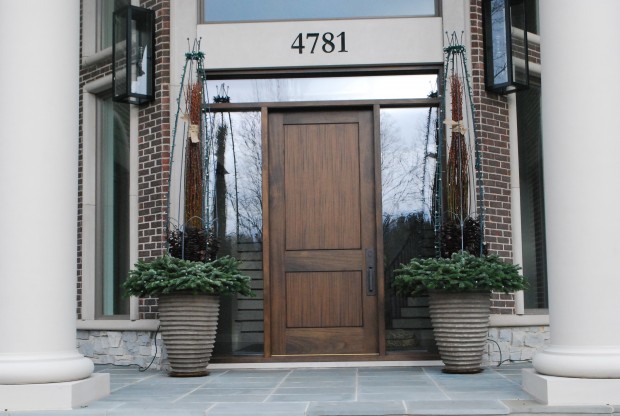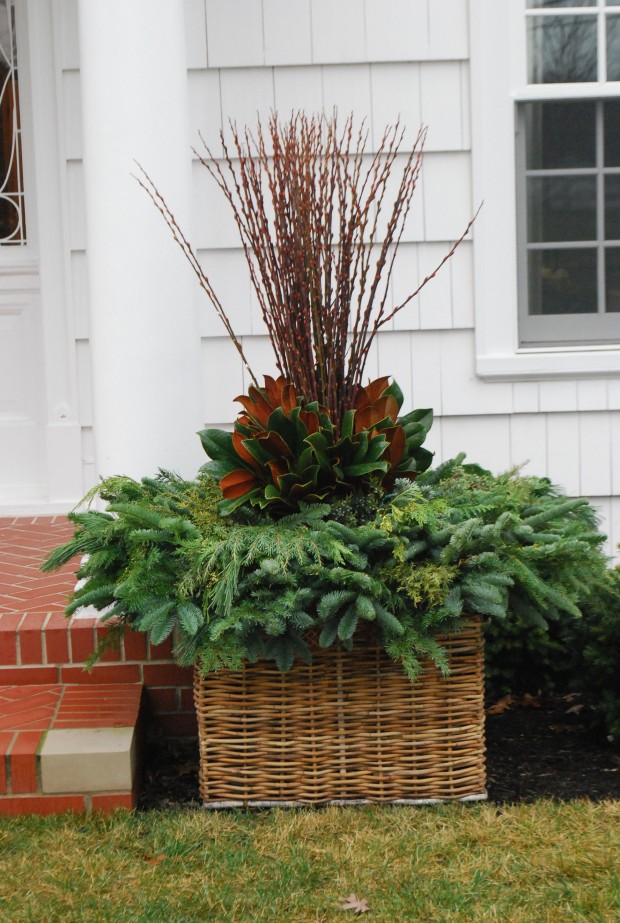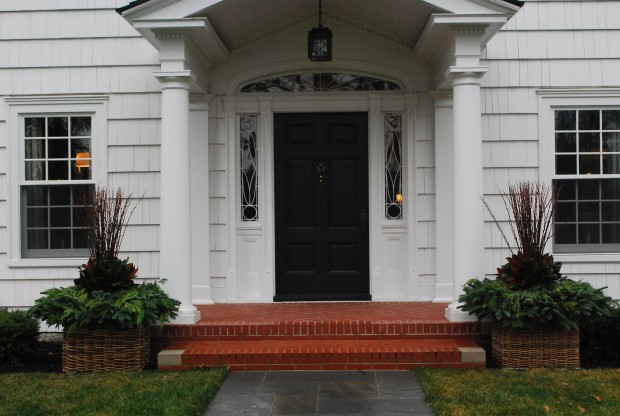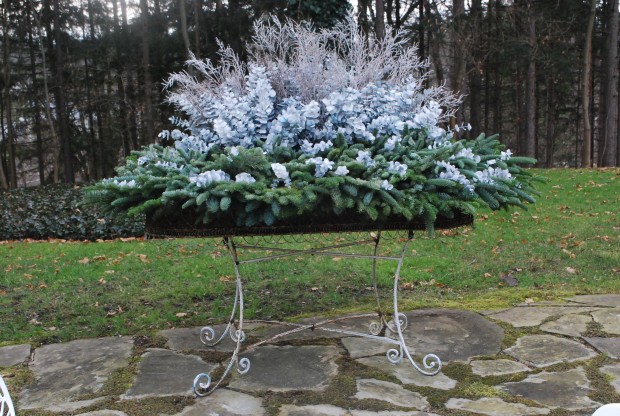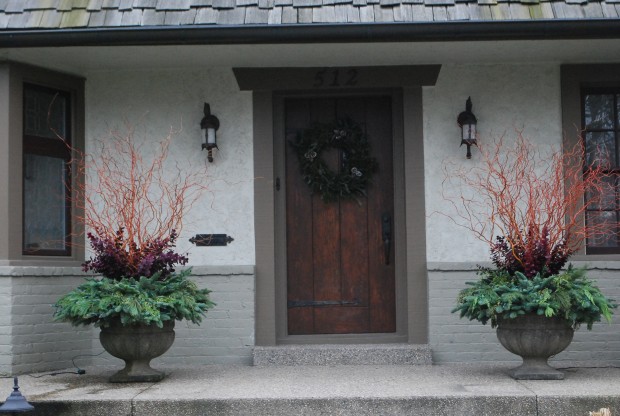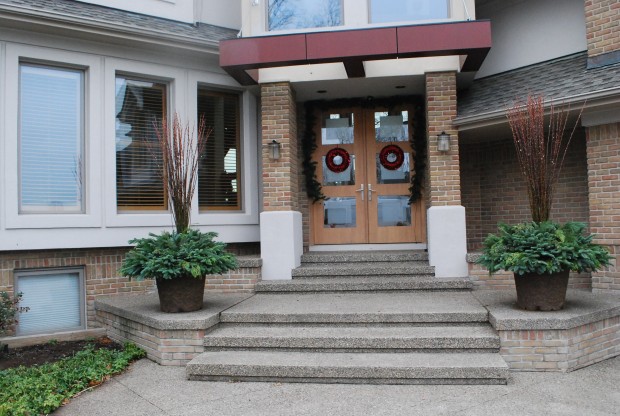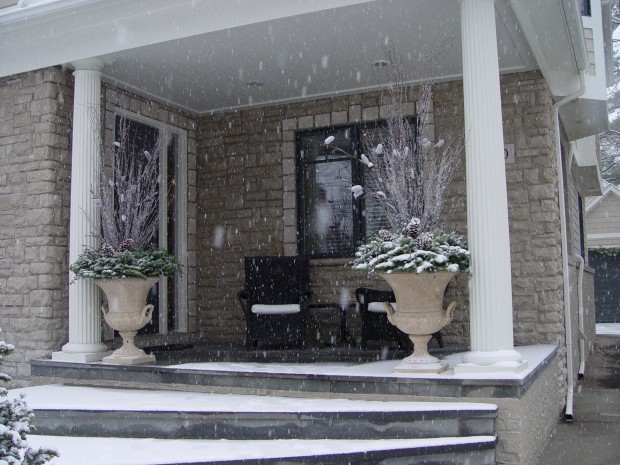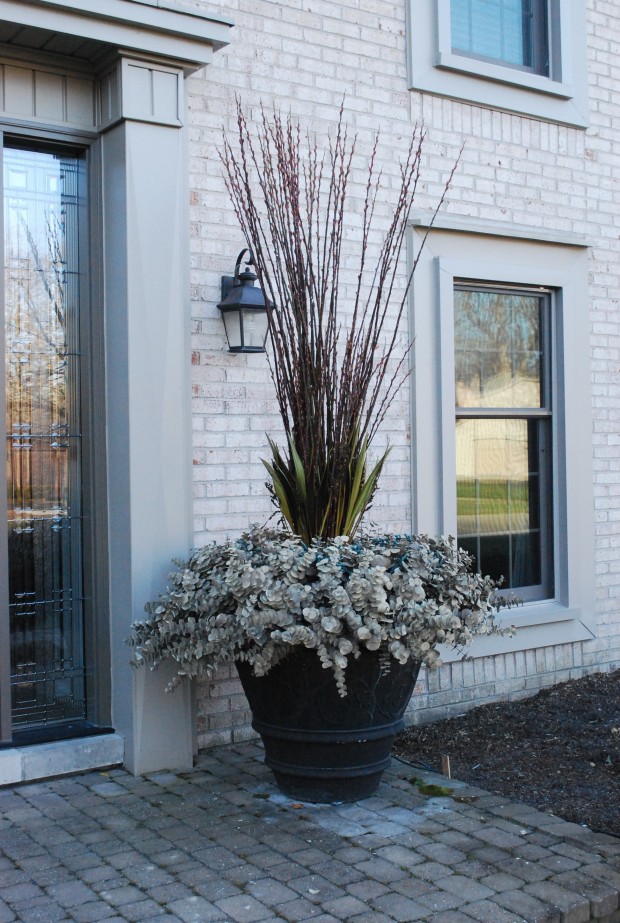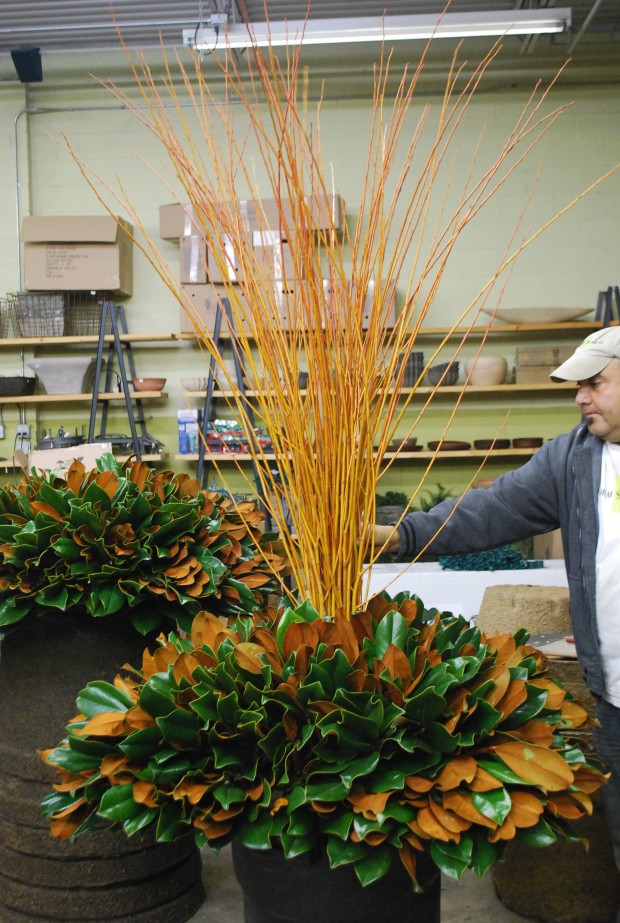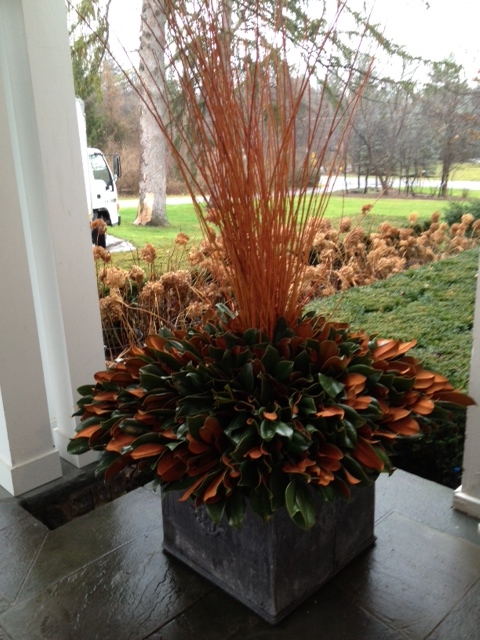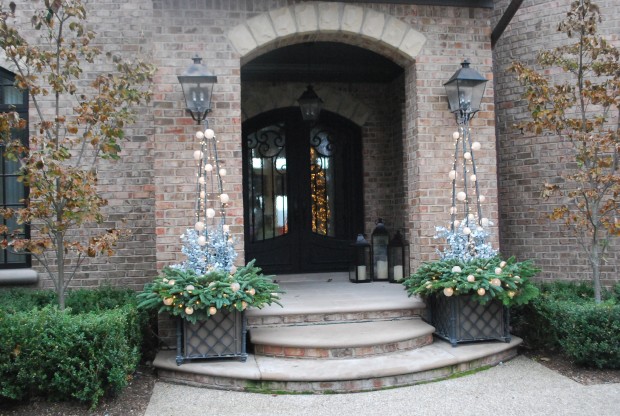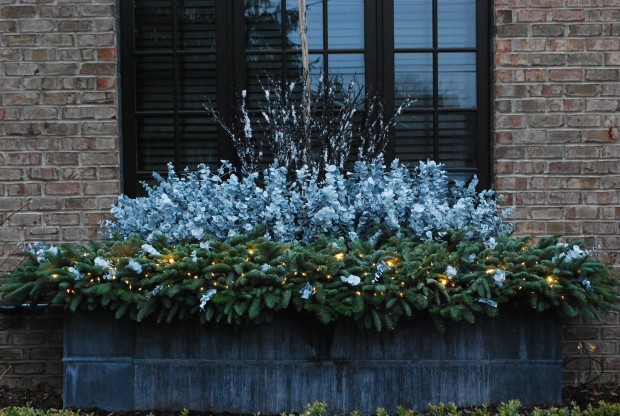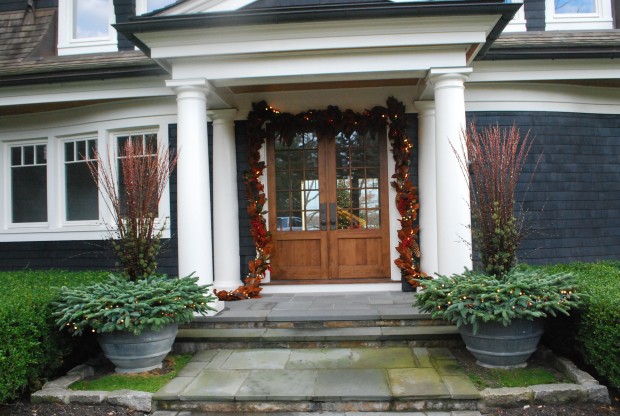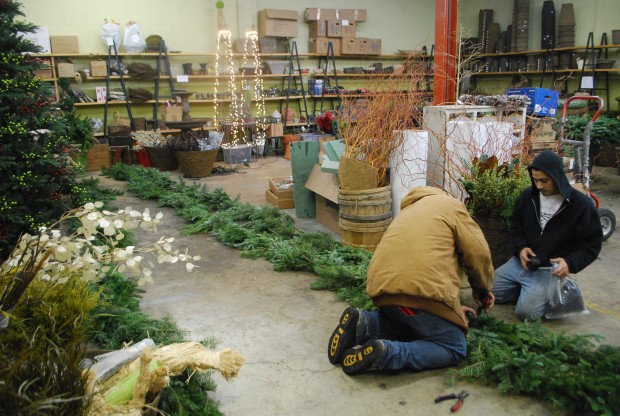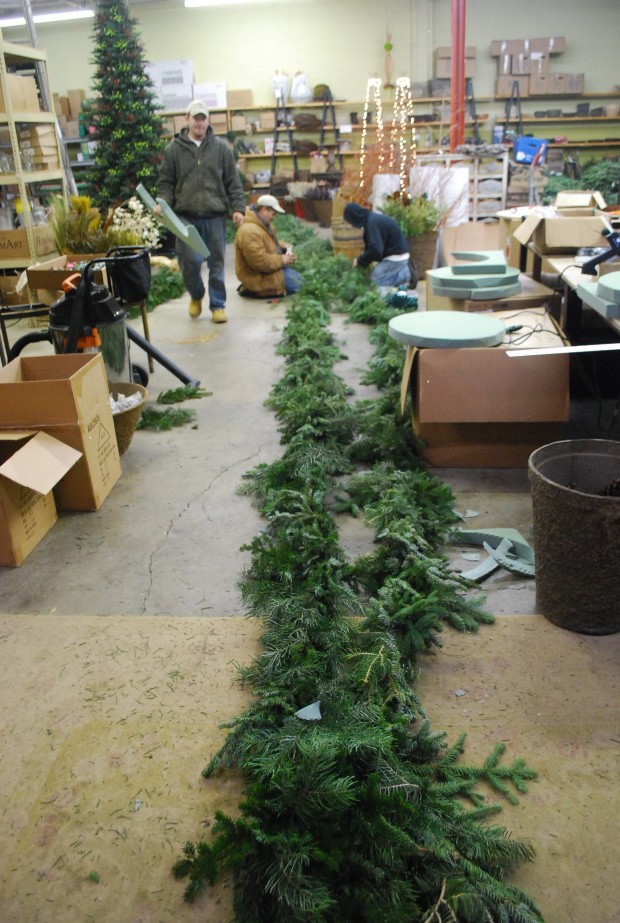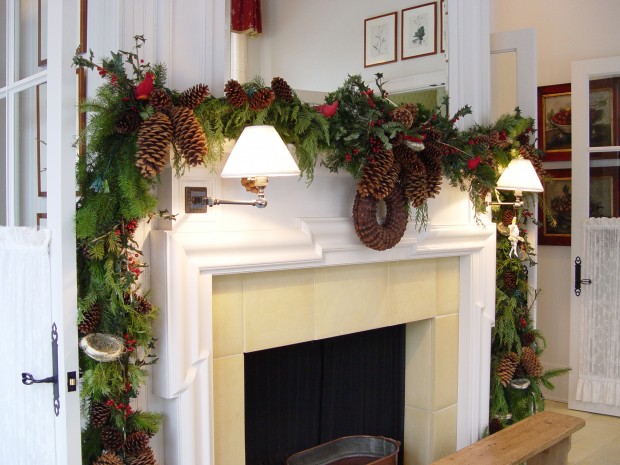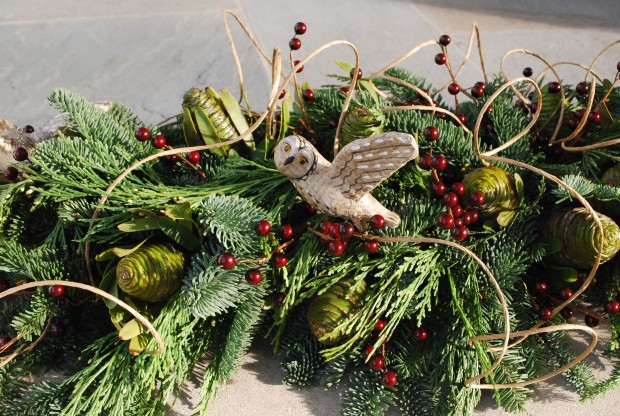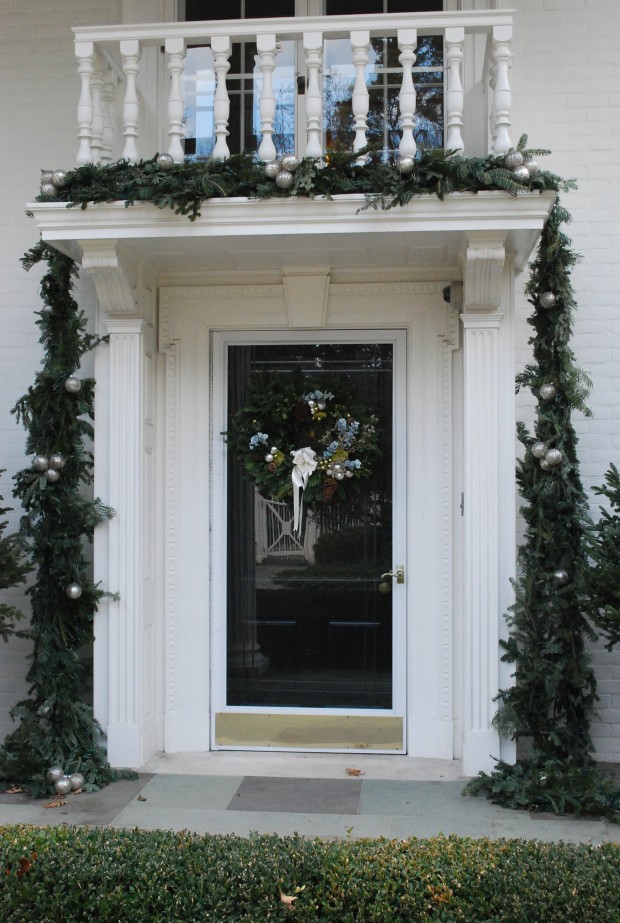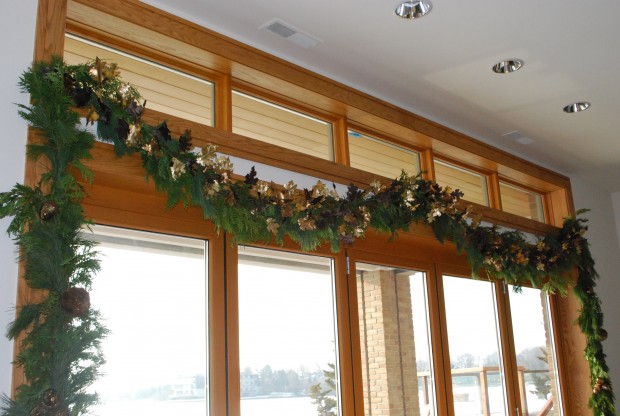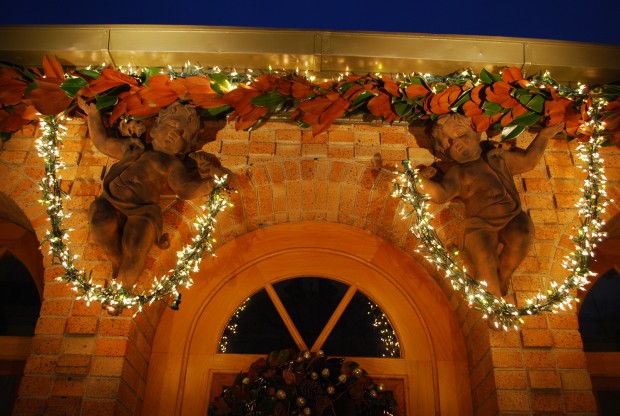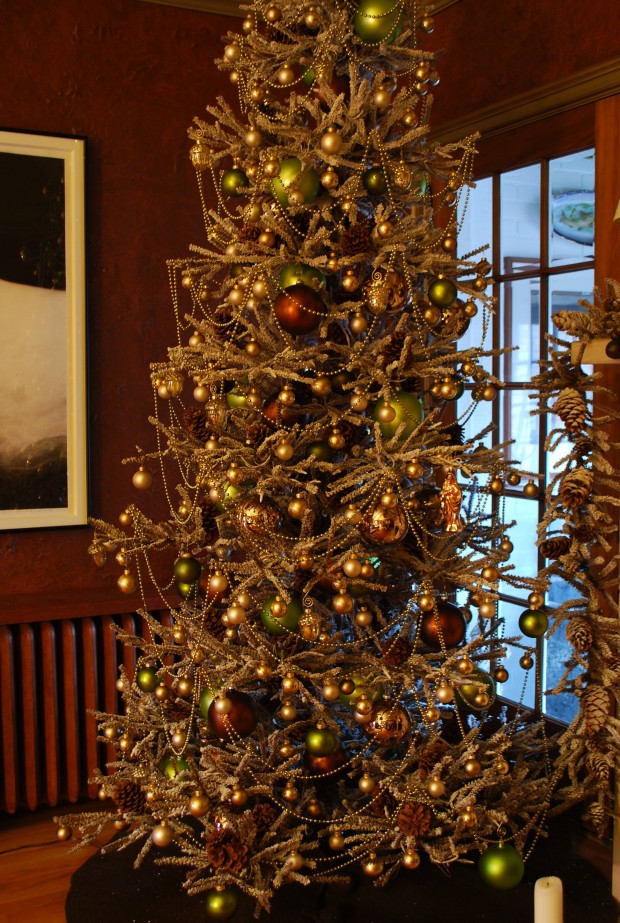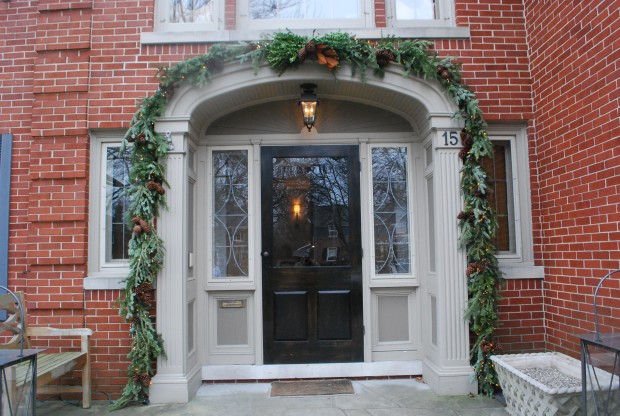I am almost done with the holiday and winter work. Sometimes some of the best comes at the last. These pots could not be simpler-sticks and lights.
Archives for December 2012
Dark Days
Light is such a powerful element in the landscape- critical to the well being of plants and people alike. The story of how light from the sun reaches the earth is astonishing. But more importantly, light is life giving, and life sustaining. There would be no garden without it. No wonder that at that time of year that the light is so low in the sky, and shy to show itself at best, the garden sleeps. Would I choose to hibernate if I could? No. I like the daily schedule-the dawning of a new day, the close of the old. My garden has no need of a daily dose of vitamin D. It sleeps.
I am awake by 5:30 am, and still awake at 9:30 pm. This means I am spending a lot of time in the dark. The light retreats early this time of year. At five past five, the landscape is largely dark. On a good day, the sky is still streaked with the remains of the light of the day at 5pm. The light sleepily emerges, after 7:30 am. Lighting the winter landscape is naturally on my mind.
No artificially generated light could possibly replace the light that comes from the sun. A sunny spring, summer, fall, or that rare sunny winter day-enchanting. Those seasons, days, and times when there is little in the way of light, gardeners have options. Votive candles glowing in the winter season-not so much a representation of the light from the sky, but a special kind of light with its own warmth and charm.
The landscape can be beautifully, and differently, lit in the winter. I took this picture at the shop very early in the morning. The holiday incandescent lighting is very different than the light on the fountain-courtesy of a photocell light on the building. Different kinds of light in concert makes the night view more interesting.
The loss of the summer sun-there is nothing to be done for it. This means that any effort to light the night will cheer the lot of us. The work of lighting the winter night can be as simple as a lighted pot at the porch or a garland hung in a tree. It can be as festive and inviting as what you see here. I hope next year to convince them to light the underhand of the tower. This would wash the second story with a little light.
The bright lights here come via one of Rob’s light rings, and the lights in greens in the window boxes. The light washing the walls is too strong-I think the fixture needs to be further away from the wall, or the wattage in the fixture turned down. Some light needs to be soft, and some light should be strong. Thoughtful visual punctuation, and rhythm is important to successfully lighting a winter landscape.
Winter light is entertaining at a time when not so much outside entertains. Once the snow comes, the light will be all the more interesting, given that stormy relationship. Winter lighting is anything but uniform. It is directed. This creates opportunityfor a lot of visual drama. Stand outside in the dark, and imagine how and where some light would delight you.
The materials for lighting your night are readily available. Extending a warm welcome has never been easier to achieve.
More On Winter
This past week was devoted to getting a lot of clients ready for the holidays and the winter to come. Every client’s take on the season is different. How I love that. Every project we do involves different materials, different emphasis, different style, different execution.
There are those landscapes that are very spare-they ask for seasonal company in the same vein. There are those who love sparkles, and those who want anything but.
The architecture makes its own demand. Ignore that, and your winter container arrangements will look jarringly out of place. These containers look in keeping with an idea that was established by the architecture.
There are those who delight in the light. I will confess I am one of them. The daytime look here-sumptuous. The night time look-electric.
This client has small children. The mudroom door-this is their front door. A dog, and a few pots dressed for the season-appropriate to the occasion.
We had occasion to obtain a number of French made baskets with leather handles. Not that you could spot those handles here, but they finish this basket in a very beautiful way. I am sure the original intent never involved a winter container arrangement.
How beautiful and comfortable they look at this front door. Though the arrangement is simple and subdued, the overall shapes are generous and clear.
This 19th century white painted wirework planter is a garden ornament/container that organizes this entire garden. For the winter, an arrangement that is just as serious as the planter. I am particularly pleased about how this looks-and will look-all winter.
These mossed topiary sculptures in French pots add a graceful note to this massive stone fireplace. They will be a welcome and personal note-all winter long.
The shape and size of a container, and the location of those containers, provides plenty of clues about how to shape and size an arrangement.
This client has beautiful terra cotta pots that sit on this porch during the summer months. In the winter, we fill fiber pots with twigs and greens. Very simple and uncomplicated, yes. What would be complicated would be the idea of living with this massive porch all winter long-bare.
Michigan winter weather adds its own touch to every winter container arrangement. This is why we construct them to withstand whatever nature has to dish out. We might get a dusting of snow. We might be buried in it.
Eucalyptus is a plant whose stems and leaves are amenable to absorbing color, and preservative. I would not want to do without this material over my winter. A winter container stuffed full of eucalyptus-not too dressy or dramatic. Just warm.
Another material not native to my zone-southern magnolia. I buy the branches by the caseload. The glossy leaves hold up over my winter beautifully. The leaves dry the most gorgeous shade of pale platinum green you could imagine. The cinnamon brown felted backs of the leaves-this color is persistent. Winter long. The color and shape of the willow-a great companion.
The relationship of the color of dried limelight hydrangea flowers to the willow and magnolia-pleasing.
Whitewashed eucalyptus is a material of choice for those clients that swear by white. Interested in pairing materials? Noble fir has that blue white cast that makes it a natural companion for whitewashed eucalyptus.
That very same eucalyptus is a gorgeous companion for the containers we make at Branch. Steely blue.
Any container that sits empty over the winter bothers me. I like the idea that no matter the season, the spirit of the garden goes on. I know my trees, shrubs and perennials are sleeping. Fine. It is about to be winter. But if I have anything to say about it, I fill the pots. To overflowing. Welcome, winter.
Festooned
A festoon is a decorative chain or strip hung between two points-this I relay to you from the dictionary. The holiday celebration provide plenty of encouragement to drape, swag, run, attach, and hang garlands-both inside and out. A garland can be a wreath-hung on a door. Or placed horizontally over the top of a birdbath. Or over the light fixtures at the front door. Or in the windows. A wreath in every window-lovely.
A length of garland, or a festoon, can be made from lots of materials, strung together. Evergreen garlands are our most popular garland. An evergreen garland is not only beautfiul to look at, it smells great. All of our garland is custom made, from three diferent types of fir. Douglas, noble and concolor fir make an evergreen garland with lots of volume.
Our garlands are triple the size of ordinary garland. I like a generous look over a door, or swagged on a gate. In places where an entrance is really large, I double over the garland, which makes it between 15-18 inches wide. Fresh garland of this size is extremely heavy-all of those branches are attached to wood from whence those green branches came.
If we need 50 feet of garland to go over an entrance or porch, we cut that garland in half, and reattach it in the center, so the branches are pointing in the same direction, whether they are on the left side, or the right side. I find a garland where the branches go up one side, and down the other visually disconcerting. All up, or all down-take your pick.
Should the branch tips face up, or down? I like all of the leaves of a magnolia garland to face up. As the leaves dry, they succumb to gravity, fall, and open up. This makes the garland wider. The leaves curl beautifully as they dry. An upfacing position will give each leaf room to make its own statement. If magnolia leaves face down, they will close even tighter as they dry-gravity will make the leaves hug the woody stems.
Evergreen garland hung with the branches facing up will have a wild, cottagy, and rustic look. The branches will fall out and down. This is a great look for a large stone fireplace, an oversized wood arbor, a wood fence of good size, or over the barn door. An evergreen garland for a more formal home might be more subtle and contained, with the branches facing down.
Many garlands are created by tieing boughs to a stout rope. Thus the word-roping. The rope is much more flexible than the boughs-eventually the greens will conform to the shape in which they are hung. A small garland designed for a dining room table might have small branches wired to make a length, as pictured above. A garland can be very short, and very striking. Or very long, and equally striking.
Garland on a mantel can be a challenge, if the mantle is very shallow. I have never been successful in convincing a clients to put brads in a mantel, so I can wire the garland to it-I have no idea why. This is why garland clips and heavy candlesticks are so popular on the mantel-they keep the garland in place. I sometimes put heavy pots on a mantel, and tuck the garland behind them. This keeps everything secure.
We do on occasion attach boughs to a stout bamboo stake, cut a foot or two shorter than the mantel. The stake keeps the entire assemblage where it belongs on a very shallow mantle. If you choose this method of construction, be sure to cut off the branchlets on the back side, so the pole can sit right next to the wall. We almost always insert extra greens into the garland after it is in place, so it looks thick and full.
To drape, or not to drape? In very formal rooms, I like the garland the width of the mantel. If the garland in a formal room drapes to the floor, how the garland pools on the floor is very important. Pooling garland on the floor like heavy taffeta drapes can be beautiful. On occasion, on a formal exterior portico, I will widen the garland at the bottom, so it pools like heavy drapes. This means adding extra branches, or an extra section of garland about half way down.
In informal rooms, I love the evergreen mantel garland to the floor. Bulky, not too controlled, and friendly. I like it loaded with other natural materials. Sugar pine cones, dried stems, eucalyptus, berries-the list of materials that can festoon your garland is long. Wired burlap ribbon, twisted and swagged, can be a beautiful companion.
Not all garlands need to be constructed from evergreens. Rob is well known for his light garland design-we make lots of them. They may look a little stilted when they are first hung-be sure you measure the lengths you are swagging-do not count on your eye. Once those light garlands come on, the heat warms the wires-when warm, they swoop beautifully.
Any material can be attached along a flexible base to make a garland. Pine cone garlands are dense and stiff. They are great in a straight run. Need them to drop? Cut them, and rewire at that spot you need them change direction. A few years ago I found tubes of platinum colored bead garlands in 30 foot lengths at English Gardens. They were beautiful on my tree-like jewelry. Gorgeous garland.
Festive-this is what garland provides to a home and a garden at the holidays. This holiday garland is quietly elegant. Just like my clients. My garland over my front door-I leave it up all winter. If the neighbors think I am eccentric, they don’t say so. It could be they like it as much as I do.
